Advancing Maritime Safety: A Literature Review on Machine Learning and Multi-Criteria Analysis in PSC Inspections
Abstract
1. Introduction
1.1. Maritime Safety and PSC Inspection
1.2. Application of MLMs in PSC
- Supervised learning methods (SLMs) use labeled data to train models that enable the prediction or classification of new data based on previous experience.
- Unsupervised learning methods (ULMs) do not require labeled data and are applied to detect hidden patterns and structures in the data, which helps discover new relationships or clusters among the data.
1.3. Application of MCDMs in PSC Inspections
1.4. Application of Combined ML and MCA Methods in the Context of PSC Inspections
2. Materials and Methods
2.1. Bibliography Data Description
2.2. Literature Review Methodology
- (P)opulation refers to all studies, papers, dissertations, and articles related to PSC inspections.
- (I)ntervention focuses on the application of methods such as MLMs and MCA in analyzing PSC inspections.
- (C)omparison analyzes different approaches to the application of MLMs and MCA in the field of PSC inspections and compares them with other methods of safety risk analysis.
- (O)utcome identifies and evaluates safety risks on vessels and the improvement of existing methods and models in the context of PSC inspections.
- (C)ontext refers to the application of these methods in the field of maritime inspections, with a particular focus on vessel safety research and the implementation of the relevant technologies.
3. Results
4. Discussion
5. Conclusions
Funding
Data Availability Statement
Conflicts of Interest
Abbreviations
| AHP | Analytic Hierarchy Process |
| AI | Artificial Intelligence |
| ANN | Artificial Neural Network |
| BM | Bayesian Model |
| BN | Bayesian Network |
| CR | Critical Review |
| DL | Deep Learning |
| ELECTRE | Elimination Et Choix Traduisant La Realité (Elimination And Choice Translating Reality) |
| IMO | International Maritime Organisation |
| k-NN | K-Nearest Neighbors |
| LIME | Local Interpretable Model-agnostic Explanations |
| MARPOL | International Convention For The Prevention Of Pollution From Ships |
| MCA | Multi-Criteria Analysis |
| MCDM | Multi-Criteria Decision-Making |
| ML | Machine Learning |
| MLM | Machine Learning Model |
| MoU | Memorandum Of Understanding |
| NLR | Narrative Literature Review |
| NN | Neural Network |
| PCA | Principal Component Analysis |
| PICOC | Population, Intervention, Comparison, Outcome, And Context. |
| PROMETHEE | Preference Ranking Organization Method For Enrichment Evaluation |
| PSC | Port State Control |
| SHAP | SHapley Additive exPlanations |
| SLM | Supervised Learning Method |
| SLR | Systematic Literature Review |
| SOLAS | International Convention For The Safety Of Life At Sea |
| SR | Scoping Review |
| SSL | Semi-Supervised Learning |
| STCW | International Convention On Standards Of Training, Certification, And Watchkeeping For Seafarers |
| SVM | Support Vector Machine |
| SVR | Support Vector Regression |
| TOPSIS | Technique for Order of Preference by Similarity to Ideal Solution |
| ULM | Unsupervised Learning Method |
References
- International Maritime Organization. Port State Control. Available online: https://www.imo.org/en/ourwork/msas/pages/portstatecontrol.aspx (accessed on 11 January 2025).
- Bhatia, B.S.; Carrera-Arce, M.; Baumler, R.; Grech, M.R. Seafarers vs. Port State Control: Decoding Work/rest Compliance Data Disparity. Mar. Policy 2024, 163, 106105. [Google Scholar] [CrossRef]
- Bolat, F.; Alpaslan, S. Cumulative analysis of Port State Control based on Paris MoU inspections. Trans. Marit. Sci. 2021, 10, 224–246. Available online: https://hrcak.srce.hr/258064 (accessed on 15 May 2025). [CrossRef]
- Liu, K.; Yu, Q.; Yang, Z.; Wan, C.; Yang, Z. BN-based port state control inspection for Paris MoU: New risk factors and probability training using big data. Reliab. Eng. Syst. Saf. 2022, 224, 108530. [Google Scholar] [CrossRef]
- Chuah, L.F.; Mokhtar, K.; Abu Bakar, A.; Othman, M.R.; Osman, N.H.; Bokhari, A.; Mubashir, M.; Abdullah, M.A.; Hasan, M. Marine environment and maritime safety assessment using Port State Control database. Chemosphere 2022, 304, 135245. [Google Scholar] [CrossRef] [PubMed]
- Biočić, T.; Frančić, V.; Hasanspahić, N.; Maglić, L. The analysis of the deficiencies resulting from Paris MoU PSC inspections. Naše More 2023, 70, 228–238. [Google Scholar] [CrossRef]
- Wu-Hsun, C.; Yi-Yang, H.; Chien-Chung, Y. Application of Machine Learning to Maritime Safety. In Proceedings of the International Symposium on Maritime Innovation (ISMI), Singapore, 17–21 October 2022; IEEE: Piscataway, NJ, USA, 2022. Available online: https://www.conf.tw/site/userdata/1449/ISMI_paper/ISMI2022_paper_5987.pdf (accessed on 15 May 2025).
- Dinis, D.; Figueira, J.; Teixeira, A.P. A multiple criteria approach for ship risk classification: An alternative to the Paris MoU Ship Risk Profile. Soc. Econ. Plan. Sci. 2023, 90, 101718. [Google Scholar] [CrossRef]
- Tsou, M.C. Big data analysis of port state control ship detention database. J. Mar. Eng. Technol. 2019, 18, 113–121. [Google Scholar] [CrossRef]
- Yang, Z.; Yang, Z.; Yin, J.; Qu, Z. A risk-based game model for rational inspections in port state control. Transp. Res. Part E 2018, 118, 477–495. [Google Scholar] [CrossRef]
- Zheng, L. The Effectiveness of New Inspection Regime on Port State Control Inspection. Open J. Soc. Sci. 2020, 8, 440–446. [Google Scholar] [CrossRef]
- Heij, C.; Knapp, S. Shipping inspections, detentions, and incidents: An empirical analysis of risk dimensions. Marit. Policy Manag. 2019, 46, 866–883. Available online: https://www.researchgate.net/publication/334747907_Shipping_inspections_detentions_and_incidents_an_empirical_analysis_of_risk_dimensions (accessed on 15 May 2025). [CrossRef]
- Şanlıer, Ş. Analysis of port state control inspection data: The Black Sea Region. Mar. Pol. 2020, 112, 103757. [Google Scholar] [CrossRef]
- Cariou, P.; Wolff, F.C. Identifying substandard vessels through port state control inspections: A new methodology for concentrated inspection campaigns. Mar. Pol. 2015, 60, 27–39. Available online: https://ideas.repec.org/a/eee/marpol/v60y2015icp27-39.html (accessed on 15 May 2025). [CrossRef]
- Chen, J.H.; Zhang, S.H.; Xu, L.; Wan, Z.; Fei, Y.J.; Zheng, T.X. Identification of key factors of ship detention under port state control. Mar. Pol. 2019, 102, 21–27. [Google Scholar] [CrossRef]
- Zhu, J.H.; Yang, Q.; Jiang, J. Identifying crucial deficiency categories influencing vessel detention: A method of combining cloud model and prospect theory. Reliab. Eng. Syst. Saf. 2023, 230, 108949. [Google Scholar] [CrossRef]
- Rey-Charlo, R.E.; Cueto, J.L.; Piniella, F. Analyzing Port State Control Data to Explore Future Improvements to GMDSS Training. J. Mar. Sci. Eng. 2023, 11, 2379. [Google Scholar] [CrossRef]
- Lyu, P. Support a Safety Learning Culture in Port State Control Regime. Ph.D. Dissertation, World Maritime University, Malmö, Sweden, 28 October 2023. Available online: https://commons.wmu.se/cgi/viewcontent.cgi?article=3290&context=all_dissertations (accessed on 15 May 2025).
- Munim, Z.H.; Sørli, M.A.; Kim, H.; Alon, I. Predicting maritime accident risk using Automated Machine Learning. Reliab. Eng. Syst. Saf. 2024, 248, 110148. [Google Scholar] [CrossRef]
- Randić, M.; Matika, D.; Možnik, D. SWOT analysis of deficiencies on ship components identified by port state control inspections with the aim to improve the safety of maritime navigation. Brodogradnja 2015, 66, 61–72. [Google Scholar]
- Stanivuk, T.; Medić, B.; Medić, M. Statistical review of the annual report on the performance of maritime safety inspection in Croatia. Trans. Marit. Sci. 2015, 4, 41–51. [Google Scholar] [CrossRef][Green Version]
- Formela, K.; Weintrit, A.; Neumann, T. Overview of definitions of maritime safety, safety at sea, navigational safety and safety in general. TransNav 2019, 13, 285–290. [Google Scholar] [CrossRef]
- Emecen Kara, E.G.; Oksas, O.; Kara, G. The similarity analysis of Port State Control regimes based on the performance of flag states. Proc. Inst. Mech. Eng. Part M J. Eng. Marit. Environ. 2019, 234, 147509021987426. [Google Scholar] [CrossRef]
- Graziano, A.; Cariou, P.; Wolff, F.C.; Mejia, M. Port State Control Inspections in the European Union: Do Inspector's Number and Background Matter? Mar. Pol. 2018, 88, 230–241. [Google Scholar] [CrossRef]
- Almorza, D.; Prieto, J.M.; Amor-Esteban, V.; Piniella, F. Port state control inspections under the Paris Memorandum of understanding and their contribution to maritime safety: Additional risk classifications and indicators using multivariate techniques. J. Mar. Sci. Eng. 2024, 12, 533. [Google Scholar] [CrossRef]
- Yuan, C.C.; Chiu, R.H.; Cai, C. Important factors influencing the implementation of independent Port State Control regimes. J. Mar. Sci. Eng. 2020, 8, 641. [Google Scholar] [CrossRef]
- Xiao, Y.; Wang, G.; Lin, K.C.; Qi, G.; Li, K.X. The effectiveness of the New Inspection Regime for Port State Control: Application of the Tokyo MoU. Mar. Pol. 2020, 115, 103857. [Google Scholar] [CrossRef]
- Yang, Z.; Yang, Z.; Teixeira, A. Comparative analysis of the impact of new inspection regime on port state control inspection. Transp. Policy 2020, 92, 65–80. [Google Scholar] [CrossRef]
- Xiao, Y.; Qi, G.; Jin, M.; Yuen, K.F.; Chen, Z.; Li, K.X. Efficiency of port state control inspection regimes: A comparative study. Transp. Policy 2021, 106, 165–172. [Google Scholar] [CrossRef]
- Henry, D.C. Shipping and COVID-19: Protecting seafarers as frontline workers. WMU J. Marit. Aff. 2020, 19, 279–293. [Google Scholar] [CrossRef]
- Nam, D.; Kim, M. Implication of COVID-19 outbreak on ship survey and certification. Mar. Pol. 2021, 131, 104615. [Google Scholar] [CrossRef]
- Maşalacı, Ç.B.; Çakır, E. Differences in deficiency types causing ship detentions at the Black Sea Region during the COVID-19 pandemic and pre-pandemic. Mar. Pol. 2023, 151, 105553. [Google Scholar] [CrossRef]
- Prieto, J.M.; Amor-Esteban, V.; Almorza-Gomar, D.; Turias, I.; Piniella, F. Application of Multivariate Statistical Techniques as an Indicator of Variability of the Effects of COVID-19 on the Paris Memorandum of Understanding on Port State Control. Mathematics 2023, 11, 3188. [Google Scholar] [CrossRef]
- Peričin, L.; Vučetić, Š.; Barić, M.; Milin, S. Port State Control Inspections During the COVID Pandemic-Case Study: Republic of Croatia. Trans. Marit. Sci. 2024, 13. [Google Scholar] [CrossRef]
- Deng, Q.; Wan, Z.; Chen, J. Factors influencing ship detentions: Pre-and post-pandemic analysis. Ocean. Coast. Manag. 2024, 257, 107344. [Google Scholar] [CrossRef]
- Heij, C.; Knapp, S. Predictive power of inspection outcomes for future shipping accidents-an empirical appraisal with special attention for human factor aspects. Marit. Policy Manag. 2018, 45, 604–621. [Google Scholar] [CrossRef]
- Fu, J.; Chen, X.; Wu, S.; Shi, C.; Wu, H.; Zhao, J.; Xiong, P. Mining ship deficiency correlations from historical port state control (PSC) inspection data. PLoS ONE 2020, 15, e0229211. Available online: https://journals.plos.org/plosone/article?id=10.1371/journal.pone.0229211 (accessed on 15 May 2025). [CrossRef]
- Fan, L.; Zhang, M.; Yin, J.; Zhang, J. Impacts of dynamic inspection records on port state control efficiency using Bayesian network analysis. Reliab. Eng. Syst. Saf. 2022, 228, 108753. [Google Scholar] [CrossRef]
- Gómez Ruiz, M.Á.; de Almeida, I.M.; Pérez Fernández, R. Application of Machine Learning Techniques to the Maritime Industry. J. Mar. Sci. Eng. 2023, 11, 1820. [Google Scholar] [CrossRef]
- Lai, C.Y.; Liu, C.P.; Huang, K.M. Optimization of the Concentrated Inspection Campaign Model to Strengthen Port State Control. J. Mar. Sci. Eng. 2023, 11, 1166. [Google Scholar] [CrossRef]
- Yan, R. Development of Machine Learning and Data Mining Models for Port State Control Inspection. Master’s Thesis, Department of Logistics and Maritime Studies, Faculty of Business, The Hong Kong Polytechnic University, Hung Hom, Hong Kong, 2020. Available online: https://theses.lib.polyu.edu.hk/bitstream/200/10643/3/5082.pdf (accessed on 3 March 2025).
- Chung, W.H.; Kao, S.L.; Chang, C.M.; Yuan, C.C. Association rule learning to improve deficiency inspection in port state control. Marit. Policy Manag. 2020, 47, 332–351. [Google Scholar] [CrossRef]
- Yan, R.; Wang, S.; Peng, C. Ship selection in port state control: Status and perspectives. Marit. Policy Manag. 2021, 48, 600–615. [Google Scholar] [CrossRef]
- Chen, Y.; Lou, N.; Liu, G.; Luan, Y.; Jiang, H. Risk analysis of ship detention defects based on association rules. Mar. Policy 2022, 142, 105123. [Google Scholar] [CrossRef]
- Qian, C.; Lou, N.; Jiang, H.; Zhou, Y.; Shi, Y. Ship detention prediction based on ensemble learning method. In Proceedings of the 2023 7th International Conference on Transportation Information and Safety (ICTIS), Xi’an, China, 4–6 August 2023; IEEE: Piscataway, NJ, USA, 2023; pp. 1–6. Available online: https://www.researchgate.net/publication/373961303_Ship_Detention_Prediction_Based_on_Ensemble_Learning_Method (accessed on 15 May 2025).
- Farzadmehr, M.; Carlan, V.; Vanelslander, T. Contemporary challenges and AI solutions in port operations: Applying Gale–Shapley algorithm to find best matches. J. Ship. Trade 2023, 8, 27. [Google Scholar] [CrossRef]
- Demirci, S.M.E.; Cicek, K. Intelligent ship inspection analytics: Ship deficiency data mining for port state control. Ocean Eng. 2023, 278, 114232. [Google Scholar] [CrossRef]
- Junaidi, A.; Yudo, H.; Ab-Samat, H. Identification of data analysis methods and focus trends in Port State Control inspections: A comprehensive literature review. Int. J. Technol. 2024, 15, 179–194. Available online: https://ijtech.eng.ui.ac.id/article/view/6492/ (accessed on 15 May 2025). [CrossRef]
- Sheriff, A.M.; Anantharaman, M.; Islam, R.; Nguyen, H.O. An in-depth analysis of port state control inspections: A bibliometric analysis and systematic review. Marit. Bus. Rev. 2025, 10, 2454754. [Google Scholar] [CrossRef]
- Nielsen, M. Neural Networks and Deep Learning; Determination Press: Online, 2015; Available online: http://neuralnetworksanddeeplearning.com/ (accessed on 15 May 2025).
- Aria, M.; Cuccurullo, C. Bibliometrix: An R-tool for comprehensive science mapping analysis. J. Inform. 2017, 11, 959–975. [Google Scholar] [CrossRef]
- IET. Ship inspection by port state control. In Applications of Machine Learning and Data Analytics Models in Maritime Transportation; IET: Stevenage, UK, 2024; Chapter 2. [Google Scholar] [CrossRef]
- Yan, R.; Wang, S. A semi-“smart predict then optimize” (semi-spo) method for efficient ship inspection. Transp. Res. Part B 2020, 142, 100–125. [Google Scholar] [CrossRef]
- Yan, R.; Wang, S.; Cao, J.; Sun, D. Shipping domain knowledge informed prediction and optimization in Port State Control. Transp. Res. Part B 2021, 149, 52–78. [Google Scholar] [CrossRef]
- Yan, R.; Wang, S.; Zhen, L.; Jiang, S. Classification and regression in prescriptive analytics: Development of hybrid models and an example of ship inspection by port state control. Comput. Oper. Res. 2023, 163, 106517. [Google Scholar] [CrossRef]
- Deng, Q.; Wan, Z. Long-Term or Short-Term? Prediction of Ship Detention Duration Based on Machine Learning. J. Mar. Sci. Eng. 2024, 12, 2220. [Google Scholar] [CrossRef]
- Wang, S.; Yan, R.; Qu, X.B. Development of a non-parametric classifier: Effective identification, algorithm, and applications in port state control for maritime transportation. Transp. Res. Part B 2019, 128, 129–157. [Google Scholar] [CrossRef]
- Boko, Z.; Skoko, I.; Sanchez-Varela, Z.; Pincetic, T. Application of Advanced Algorithms in Port State Control for Offshore Vessels Using a Classification Tree and Multi-Criteria Decision-Making. J. Mar. Sci. Eng. 2024, 12, 1905. [Google Scholar] [CrossRef]
- Wu, S.B.; Chen, X.Q.; Shi, C.J.; Fu, J.J.; Yan, Y.; Wang, S.Z. Ship detention prediction via feature selection scheme and support vector machine (SVM). Marit. Policy Manag. 2022, 49, 140–153. [Google Scholar] [CrossRef]
- Knapp, S.; van de Velden, M. Predicting Inspection Outcomes and Evaluating Port State Control Targeting Using Random Forests. Report 2024. [Google Scholar] [CrossRef]
- Bei, H.; Yang, F.; Wang, W.; Yang, T.; Murcio, R. Maritime safety through multi-source data fusion: An AdaBoost-based approach for predictive ship detention by port state control. Mar. Pol. Manag. 2024, 51, 123–145. [Google Scholar] [CrossRef]
- Hou, Z.; Yan, R.; Wang, S. On the K-Means Clustering Model for Performance Enhancement of Port State Control. J. Mar. Sci. Eng. 2022, 10, 1608. [Google Scholar] [CrossRef]
- Osman, M.T.; Tian, L.; Chen, Y.; Abdul Rahman, N.S.F. Empirical analysis on port state control inspection for foreign-registered ships in Malaysian ports. Asian J. Shipp. Logist. 2021, 37, 127–139. [Google Scholar] [CrossRef]
- Akyuz, E.; Akgun, I.; Celik, M. A fuzzy failure mode and effects approach to analyse concentrated inspection campaigns on board ships. Marit. Policy Manag. 2016, 43, 887–908. [Google Scholar] [CrossRef]
- Yan, R.; Wu, S.; Jin, Y.; Cao, J.; Wang, S. Efficient and explainable ship selection planning in port state control. Transp. Res. Part C Emerg. Technol. 2022, 145, 103924. Available online: https://www.researchgate.net/publication/364647513_Efficient_and_explainable_ship_selection_planning_in_port_state_control (accessed on 15 May 2025). [CrossRef]
- Vasileiadis, A.; Alexandrou, E.; Paschalidou, L.; Chrysanthou, M. Artificial neural network and its applications. ResearchPDF 2024, 1, 1–15. Available online: https://www.researchgate.net/publication/380122805_Artificial_Neural_Network_and_Its_Applications (accessed on 12 January 2025).
- Boko, Z.; Stanivuk, T.; Radanović, N.; Skoko, I. Machine Learning-Driven Prediction of Offshore Vessel Detention: The Role of Neural Networks in Port State Control. J. Mar. Sci. Eng. 2025, 13, 472. [Google Scholar] [CrossRef]
- Goodfellow, I.; Bengio, Y.; Courville, A. Deep Learning; MIT Press: Cambridge, MA, USA, 2016. [Google Scholar]
- Biçen, S.; Celik, M. A Deep Learning Approach to Analyse Ship Inspection Reports via Natural Language Processing Integrated with Artificial Neural Network. J. Mar. Eng. Technol. 2024, 23, 291–304. [Google Scholar] [CrossRef]
- Chen, X.; Yang, Y.; Wang, S.; Wu, H. Ship Type Recognition via a Coarse-to-Fine Cascaded Convolution Neural Network. J. Nav. 2020, 73, 813–832. [Google Scholar] [CrossRef]
- Lim, J.J.; Kim, D.W.; Hong, W.H.; Kim, M.; Lee, D.H.; Kim, S.Y.; Jeong, J.H. Application of Convolutional Neural Network (CNN) to Recognize Ship Structures. Sensors 2022, 22, 3824. [Google Scholar] [CrossRef]
- Bonassi, F.; Farina, M.; Xie, J.; Scattolini, R. On recurrent neural networks for learning-based control: Recent results and ideas for future developments. J. Process Control 2022, 114, 92–104. [Google Scholar] [CrossRef]
- Yang, Z.; Yang, Z.; Yin, J. Realising advanced risk-based port state control inspection using data-driven Bayesian networks. Transp. Res. Part A 2018, 110, 38–56. [Google Scholar] [CrossRef]
- Fan, L.; Zhang, Z.; Yin, J.; Wang, X. The efficiency improvement of port state control based on ship accident Bayesian networks. Proc. Inst. Mech. Eng. Part O J. Risk Reliab. 2019, 233, 71–83. [Google Scholar] [CrossRef]
- Fan, L.; Zheng, L.; Luo, M. Effectiveness of port state control inspection using Bayesian network modelling. Marit. Policy Manag. 2020, 49, 261–278. [Google Scholar] [CrossRef]
- Yang, Z.; Wan, C.P.; Yang, Z.; Yu, Q. Using Bayesian network-based TOPSIS to aid dynamic port state control detention risk control decision. Reliab. Eng. Syst. Saf. 2021, 213, 107784. [Google Scholar] [CrossRef]
- Yang, Z.; Yu, Q.; Yang, Z.; Wan, C. A Machine Learning-Based Bayesian Model for the Development of Highly-Effective Port State Control Inspection Policy. SSRN 2022. Available online: https://ssrn.com/abstract=4255426 (accessed on 15 May 2025).
- Chuah, L.F.; Mohd Rof’ie, N.R.; Mohd Salleh, N.H.; Abu Bakar, A.; Oloruntobi, O.; Othman, M.R.; Mohamed Fazlee, U.S.; Mubashir, M.; Asif, S. Analyzing the influencing factors of Port State Control for a cleaner environment via Bayesian network model. Clean. Eng. Technol. 2023, 14, 100636. [Google Scholar] [CrossRef]
- Jiang, H.; Chen, Y.; Naiyuan, L.; Zhou, Y. Dynamic Evolution Analysis of Ship’s Port State Control Inspection Based on Bayesian Networks. In Proceedings of the 2023 7th International Conference on Transportation Information and Safety (ICTIS), Xi’an, China, 4–6 August 2023. [Google Scholar] [CrossRef]
- Yang, Z.; Wan, C.; Yu, Q.; Yin, J.; Yang, Z. A machine learning-based Bayesian model for predicting the duration of ship detention in PSC inspection. Transp. Res. Part E 2023, 180, 103331. [Google Scholar] [CrossRef]
- Kamal, B.; Altunışık, A. A data-driven Bayes approach for investigating International Safety Management Code-sourced detention of ships in Port State Controls. Mar. Pol. 2024, 169, 106346. [Google Scholar] [CrossRef]
- Yang, Z.; Yu, Q.; Yang, Z.; Wan, C. A data-driven Bayesian model for evaluating the duration of detention of ships in PSC inspections. Transp. Res. Part E Logist. Transp. Rev. 2024, 181, 103371. [Google Scholar] [CrossRef]
- Corrente, S.; Figueira, J.; Greco, S. Pairwise comparison tables within the deck of cards method in multiple criteria decision aiding. Eur. Oper. Res. 2021, 291, 738–756. [Google Scholar] [CrossRef]
- Çağlayan, Ö.; Aymelek, M. An Integrated Multi-Criteria Decision Support Model for Sustainable Ship Queuing Policy Application via Vessel Traffic Service (VTS). Sustainability 2024, 16, 4615. [Google Scholar] [CrossRef]
- Yan, R.; Wang, S. Ship detention prediction using anomaly detection in port state control: Model and explanation. ERA 2022, 30, 3679–3691. [Google Scholar] [CrossRef]
- Yilmaz Bolat, P.; Kayişoğlu, G.; Güneş, E.; Kizilay, F.E. Weighting Key Factors for Port Congestion by AHP Method. J. Eta Marit. Sci. 2020, 8, 252–273. [Google Scholar] [CrossRef]
- Emecen Kara, E.G. Determination of maritime safety performance of flag states based on the Port State Control inspections using TOPSIS. Mar. Pol. 2022, 143, 105156. [Google Scholar] [CrossRef]
- Taherdoost, H. Using PROMETHEE Method for Multi-Criteria Decision Making-Applications and Procedures. Iris J. Econ. Bus. Manag. 2023, 1. [Google Scholar] [CrossRef]
- Taherdoost, H.; Madanchian, M. A Comprehensive Overview of the ELECTRE Method in Multi Criteria Decision-Making. J. Mgt. Sci. Eng. Res. 2023, 6, 5–16. [Google Scholar] [CrossRef]
- Kim, J.Y.; Oh, J.S. A pilot study of stacked autoencoders for ship mode classification. Appl. Sci. 2023, 13, 5491. [Google Scholar] [CrossRef]
- He, J.; Hao, Y.; Wang, X. An Interpretable Aid Decision-Making Model for Flag State Control Ship Detention Based on SMOTE and XGBoost. J. Mar. Sci. Eng. 2021, 9, 156. [Google Scholar] [CrossRef]
- Yan, R.; Wang, S.; Peng, C.; Sun, D. An Artificial Intelligence Model Considering Data Imbalance for Ship Selection in Port State Control Based on Detention Probabilities. J. Comput. Sci. 2021, 48, 101257. [Google Scholar] [CrossRef]
- Wang, R.; Zhang, M.; Gong, F.; Wang, S.; Yan, R. Improving port state control through a transfer learning-enhanced XGBoost model. Reliab. Eng. Syst. Saf. 2025, 253, 110558. [Google Scholar] [CrossRef]
- R Project for Statistical Computing. Available online: https://www.r-project.org/about.html (accessed on 25 March 2025).
- Carrera-Rivera, A.; Ochoa, W.; Larrinaga, F.; Lasa, G. How-to conduct a systematic literature review: A quick guide for computer science research. MethodsX 2022, 9, 101895. [Google Scholar] [CrossRef]
- Mulyanto, A.; Hartati, S.; Wardoyo, R. Systematic Literature Review of Text Feature Extraction. In Proceedings of the Seventh International Congress on Information and Communication Technology, London, UK, 21–24 February 2022. [Google Scholar]

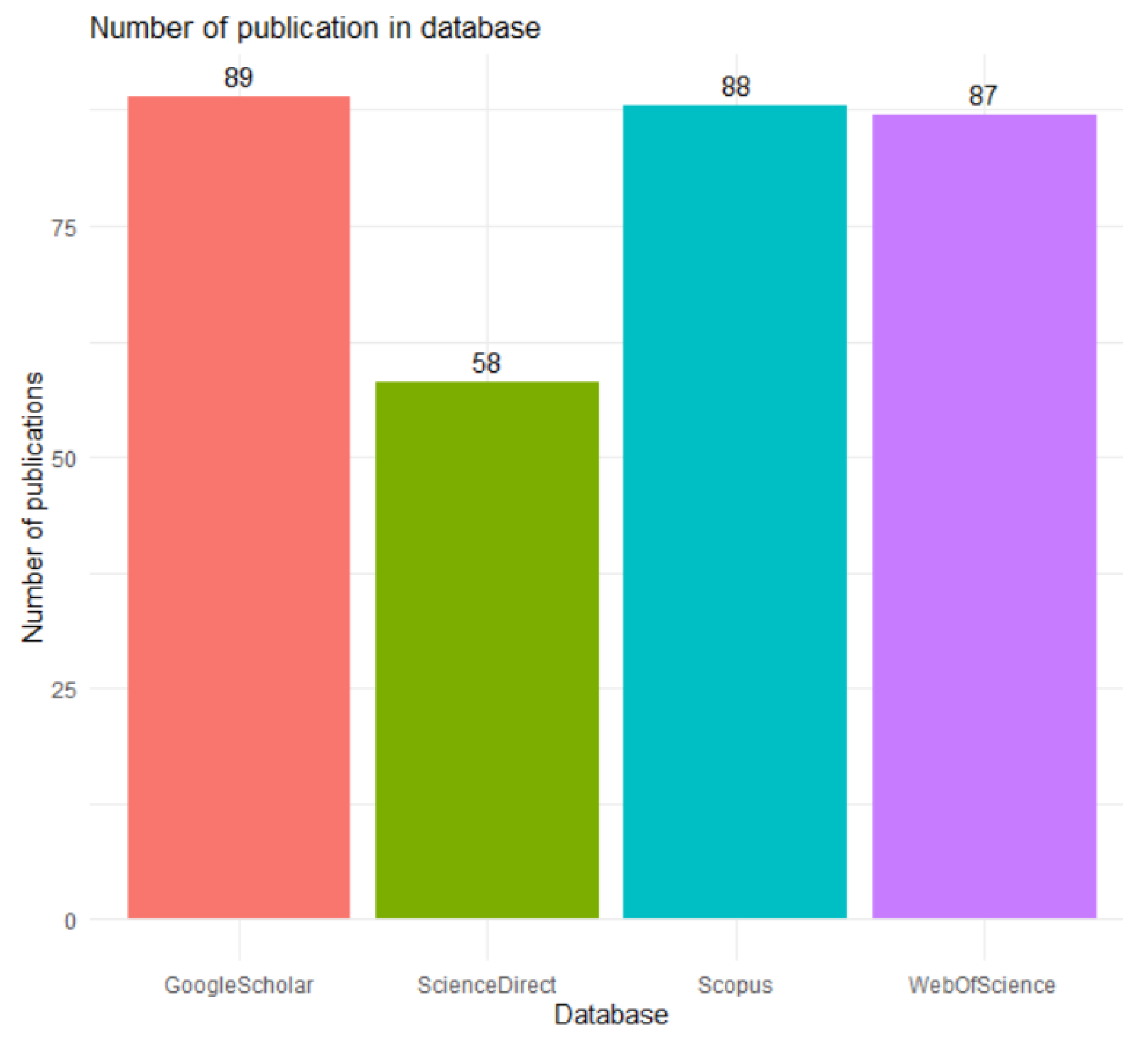
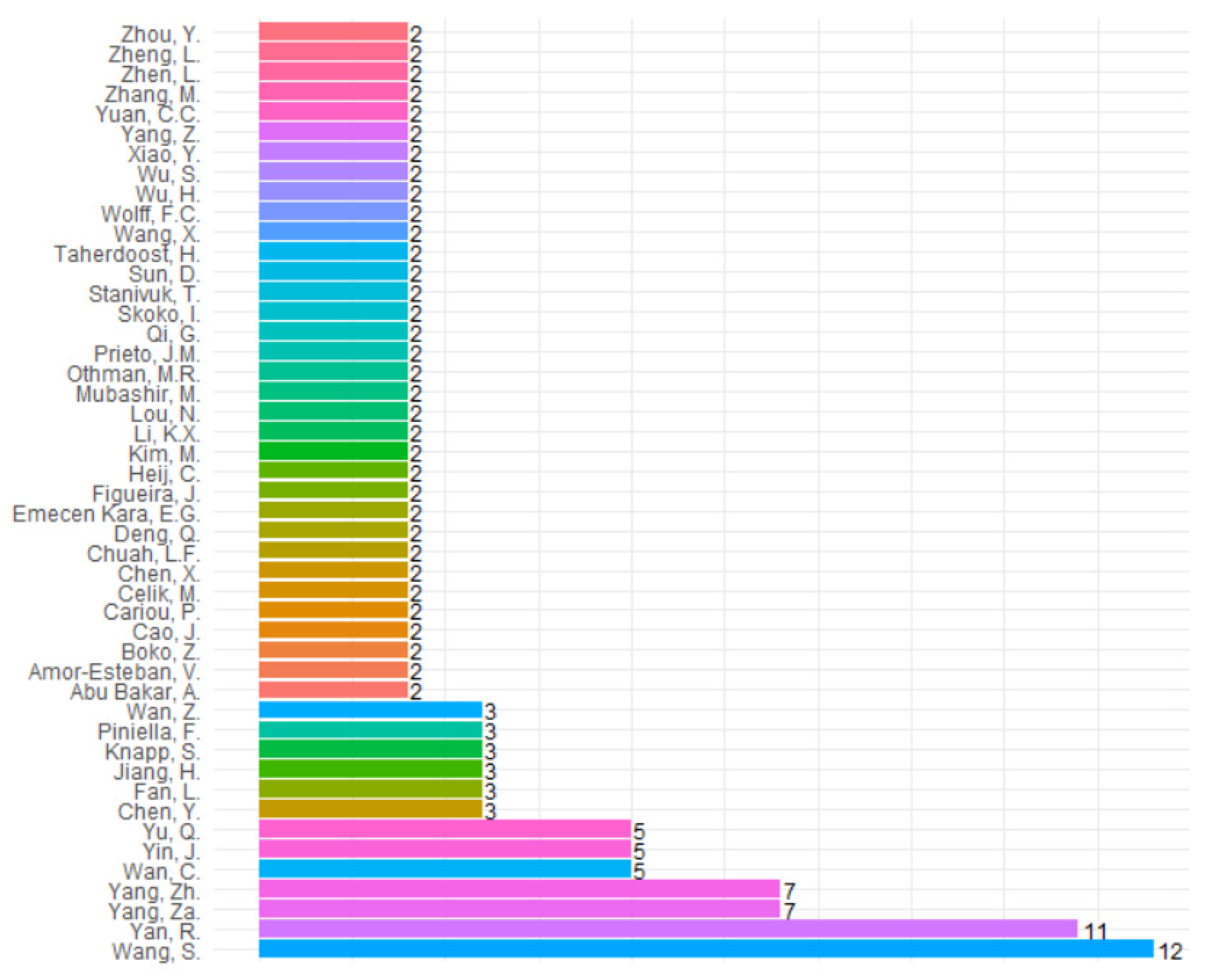
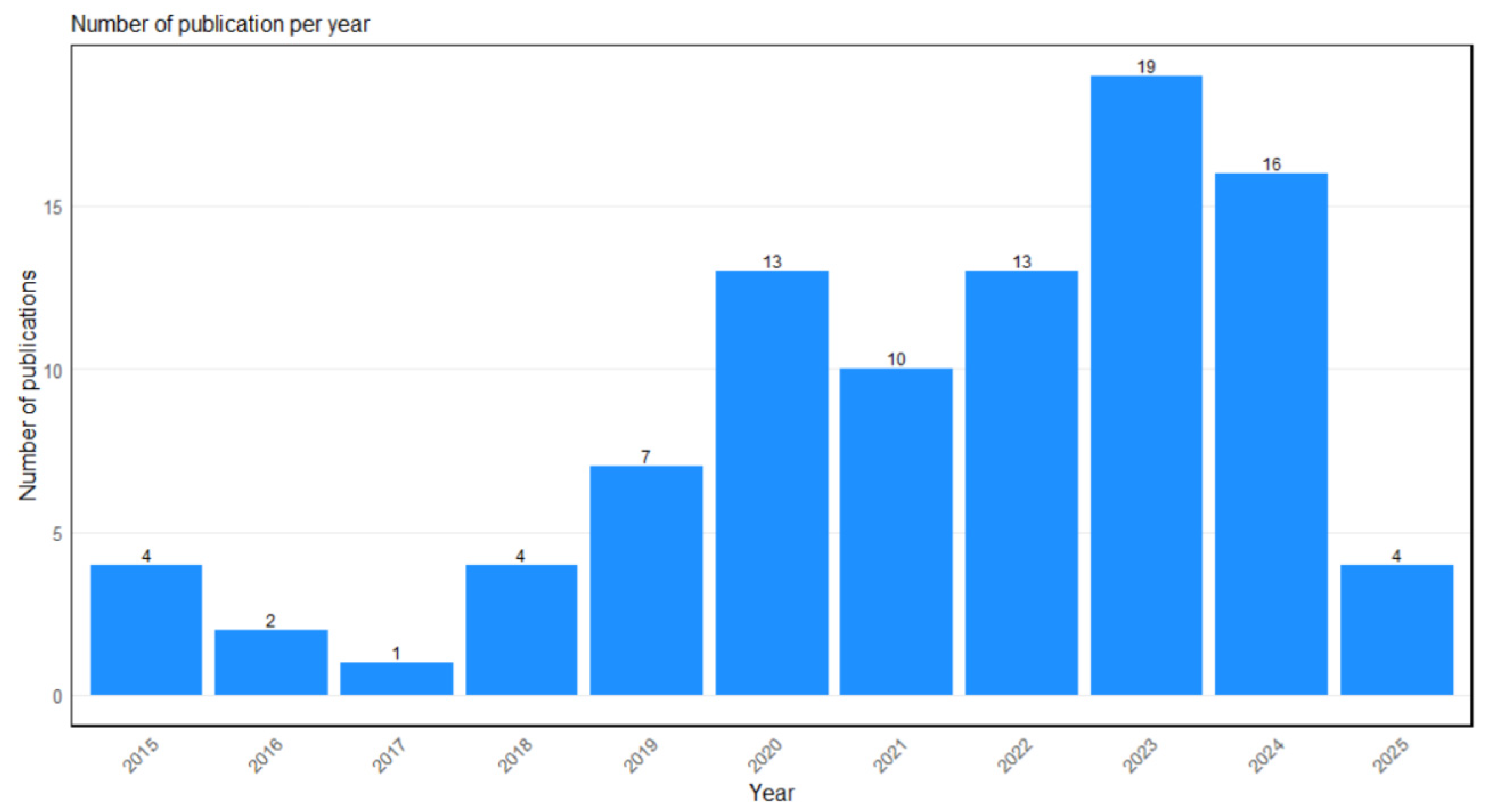
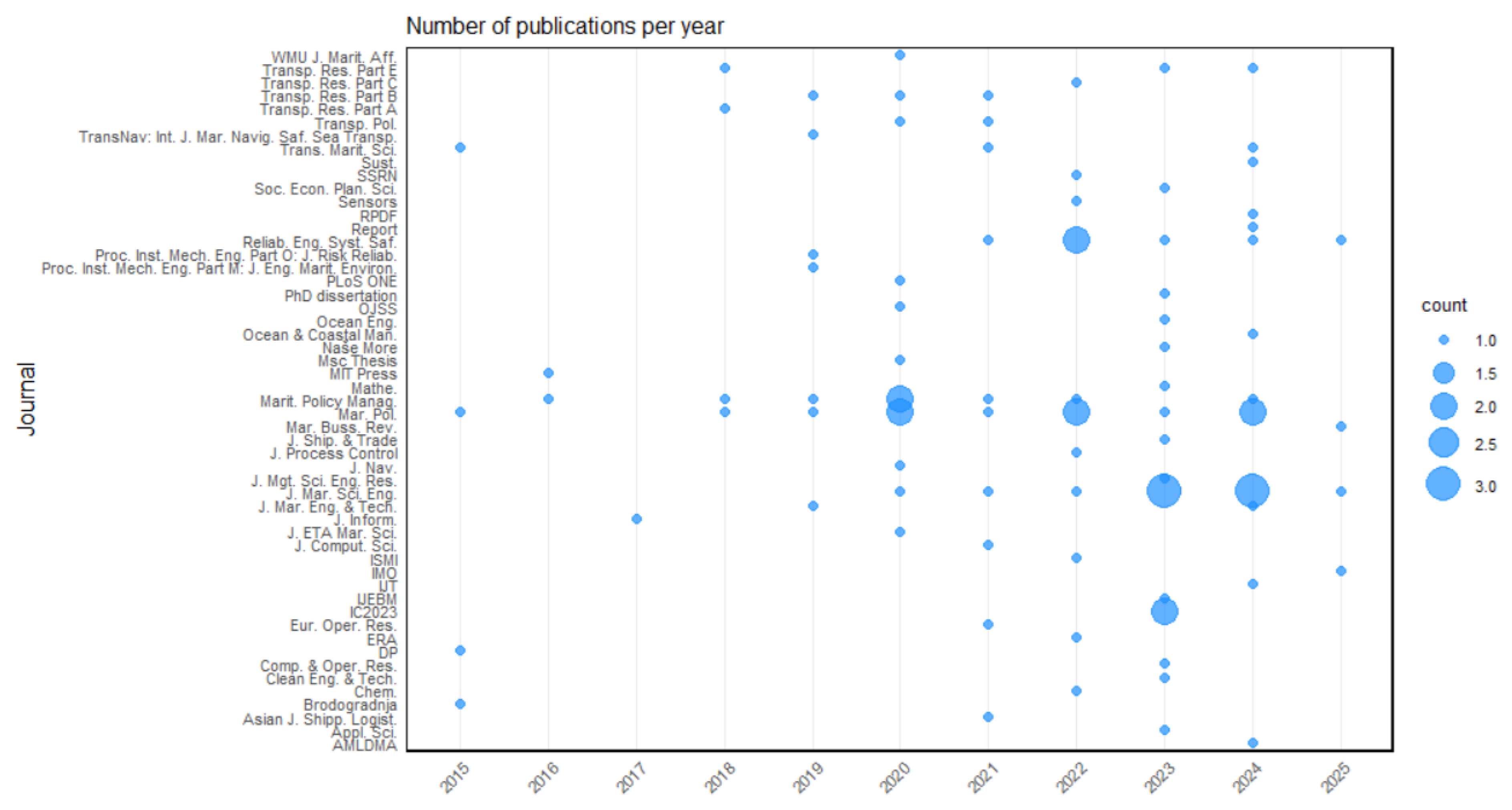
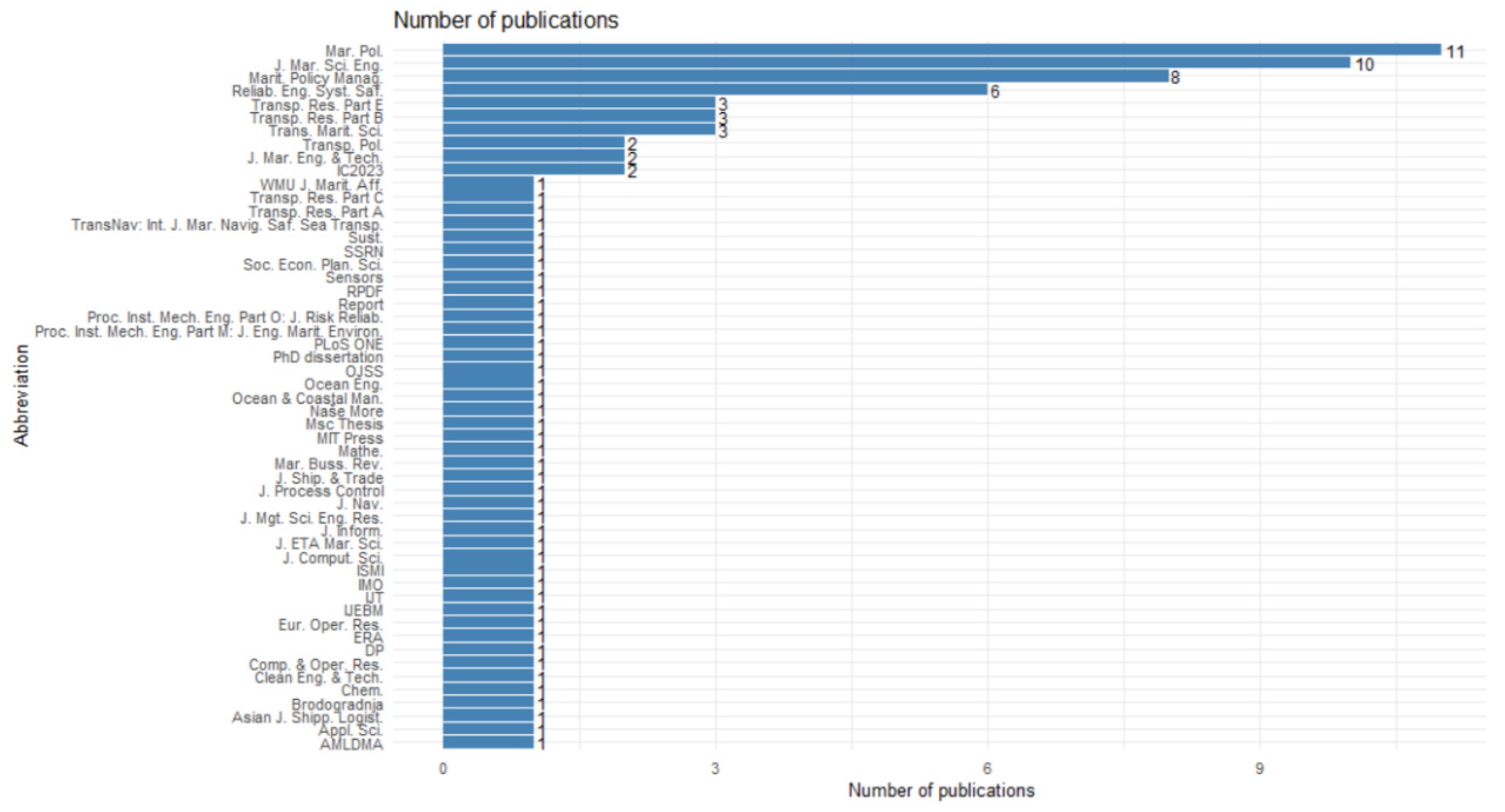

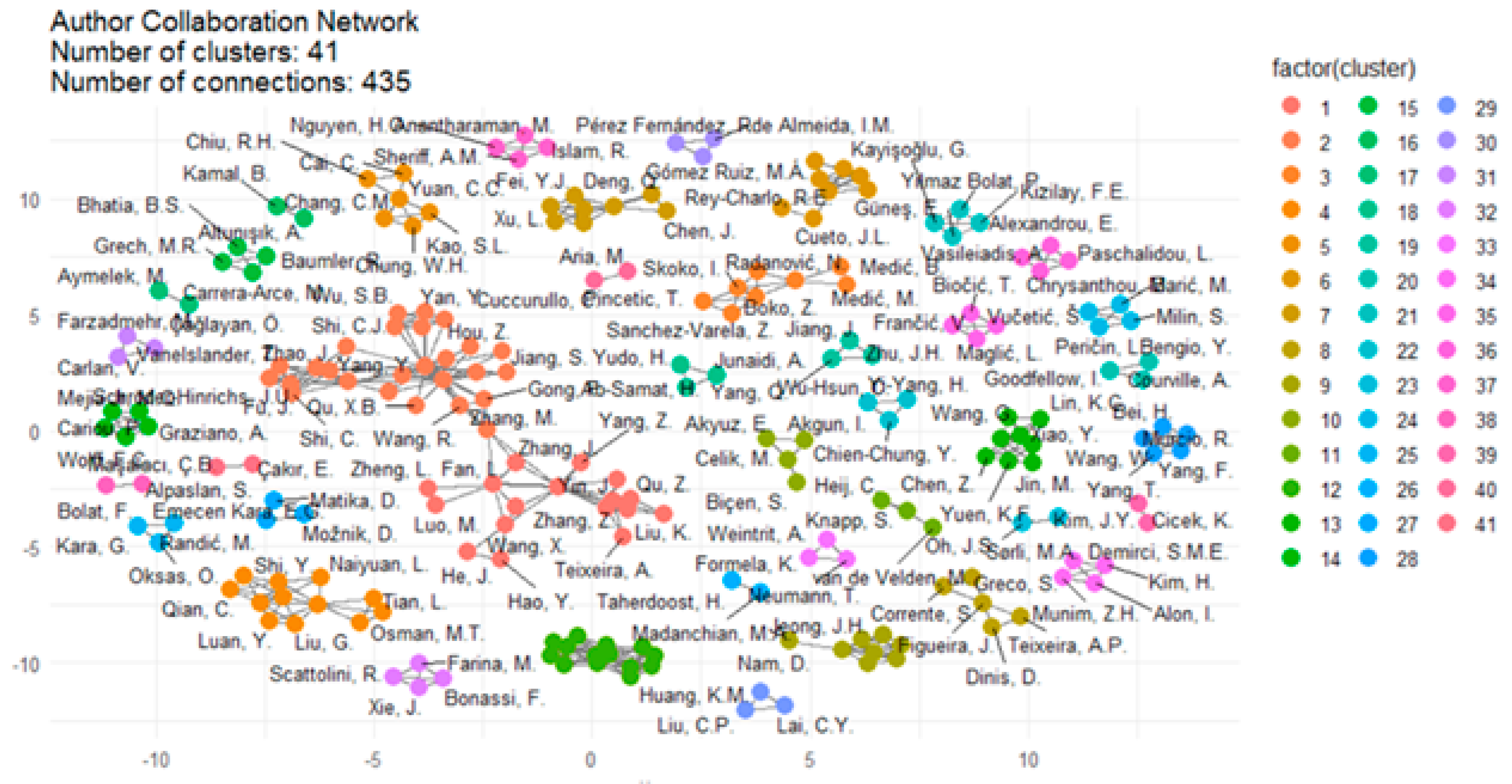
| Subject | References |
|---|---|
| PSC inspection in general | [1,2,3,4,5,6,7,8,9,10,11,12,13,14,15,16,17,18,19,20,21,22,23] |
| Maritime safety and PSC inspection | [24,25,26,27,28,29,30,31,32,33,34,35,36,37,38,39,40] |
| Application of MLMs in PSC | [16,19,38,41,42,43,44,45,46,47,48,49,52,53,54,55,56,57,58,59,60,61,62,63,64,65,66,67,68,69,70,71,72,73,74,75,76,77,78,79,80,81,82] |
| Application of MCDMs in PSC Inspections | [8,26,33,40,76,83,84,85,86,87,88,89] |
| Application of combined ML and MCA methods in the context of PSC Inspections | [46,58,76,90,91,92,93] |
| ML in general | [50,51,68] |
| Journal or Source Type | Frequency |
|---|---|
| Journal | 86 |
| Proceedings | 2 |
| Book or chapter in book | 2 |
| PhD Dissertation | 1 |
| Master of Science thesis | 1 |
| Web link | 1 |
| 1. DEFINITION OF THE RESEARCH QUESTION | Formulate a clear and concise research question using the PICOC method. Focus on the safety risks associated with PSC controls, including MLMs and MCA. |
| 2. FORMULATION OF CRITERIA FOR STUDY SELECTION | Use the PICOC framework to define specific criteria for selecting relevant studies. Define the inclusion and exclusion criteria for appropriate studies, based on factors such as research area, methodology, and publication year. |
| 3. LITERATURE SEARCH | Systematic search in relevant databases, including Web of Science, Scopus, Google Scholar, and ScienceDirect. Use of specific keywords and phrases related to MLMs, MCA, and PSC inspections. |
| 4. STUDY SELECTION | Application of the previously defined inclusion and exclusion criteria to select only relevant studies. This step involves reviewing abstracts, keywords, and conclusions. |
| 5. ASSESSMENT OF THE QUALITY OF THE STUDIES | Assessment of the quality of the selected studies based on methodological criteria. |
| 6. DATA EXTRACTION | Systematic extraction of key data from the selected studies, including methodology, results, variables analyzed, and applications of MLMs and MCA in relation to PSC inspections. |
| 7. DATA ANALYSIS AND SYNTHESIS | Analyzing and synthesizing the data from all studies to identify common themes, methodological approaches, and research gaps. Integrate findings into a unified framework that links MLMs, MCA, and PSC inspections. |
| 8. WRITING THE REPORT | Produce a report summarizing the key findings of the literature review. This report will include a critical review of methodological approaches, identification of research gaps, and suggestions for future areas of research. |
| 9. DISCUSSION AND CONCLUSIONS | Discussion on the importance of integrating MLMs and MCA in analyzing PSC inspections and the benefits and challenges of using these methods. Suggestions for further development and improvement of research in this area. |
| Number_of_Authors | Frequency |
|---|---|
| 3 | 24 |
| 4 | 24 |
| 2 | 17 |
| 1 | 11 |
| 5 | 10 |
| 6 | 3 |
| 7 | 2 |
| 9 | 2 |
| Total | 93 |
| Method | Advantages | Limitations | Effectiveness in PSC Context |
|---|---|---|---|
| Decision Trees | High interpretability; easy to apply | Lower accuracy in complex scenarios | Suitable for training and quick decision-making, but limited in complex cases |
| RF | High accuracy; robust to noisy data | Low transparency; complex structure | Very effective for risk detection, but requires additional explanation of results |
| SVM | Excellent performance on complex datasets | Difficult to interpret for non-experts | Accurate, but less applicable without expert support in operational settings |
| BN | Fast and simple; suitable for small or text-based data | Assumes feature independence, which is often unrealistic | Useful for preliminary classification and filtering |
| AHP | Structured multi-criteria decision-making | Subjectivity in determining weighting factors | Effective when decision priorities are clearly defined |
| TOPSIS | Clear rankings; focuses on proximity to the ideal solution | Limited flexibility for unstructured or dynamic data | Useful for ranking vessels based on risk level |
Disclaimer/Publisher’s Note: The statements, opinions and data contained in all publications are solely those of the individual author(s) and contributor(s) and not of MDPI and/or the editor(s). MDPI and/or the editor(s) disclaim responsibility for any injury to people or property resulting from any ideas, methods, instructions or products referred to in the content. |
© 2025 by the authors. Licensee MDPI, Basel, Switzerland. This article is an open access article distributed under the terms and conditions of the Creative Commons Attribution (CC BY) license (https://creativecommons.org/licenses/by/4.0/).
Share and Cite
Boko, Z.; Skoko, I.; Sanchez Varela, Z.; Milin, V. Advancing Maritime Safety: A Literature Review on Machine Learning and Multi-Criteria Analysis in PSC Inspections. J. Mar. Sci. Eng. 2025, 13, 974. https://doi.org/10.3390/jmse13050974
Boko Z, Skoko I, Sanchez Varela Z, Milin V. Advancing Maritime Safety: A Literature Review on Machine Learning and Multi-Criteria Analysis in PSC Inspections. Journal of Marine Science and Engineering. 2025; 13(5):974. https://doi.org/10.3390/jmse13050974
Chicago/Turabian StyleBoko, Zlatko, Ivica Skoko, Zaloa Sanchez Varela, and Vice Milin. 2025. "Advancing Maritime Safety: A Literature Review on Machine Learning and Multi-Criteria Analysis in PSC Inspections" Journal of Marine Science and Engineering 13, no. 5: 974. https://doi.org/10.3390/jmse13050974
APA StyleBoko, Z., Skoko, I., Sanchez Varela, Z., & Milin, V. (2025). Advancing Maritime Safety: A Literature Review on Machine Learning and Multi-Criteria Analysis in PSC Inspections. Journal of Marine Science and Engineering, 13(5), 974. https://doi.org/10.3390/jmse13050974








